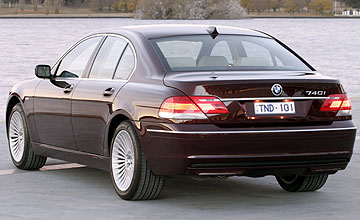BY MARTON PETTENDY | 8th Jun 2005

Launched in Australia this week, the BMW limousine instead features a pair of powerful new V8 engines, better handling, improved ergonomics and higher levels of interactivity to keep it competitive in an increasingly crowded luxury car segment.
There is also more standard equipment onboard including the so-called ConnectedDrive, a fully integrated telematics service that brings the benefits of the internet inside the car for the first time in Australia.
BMW Australia claims it all adds up to greater value-for-money, despite a $6000 price hike for the base model.
Available in both regular and long-wheelbase (Li) guises, the 7 Series revisions adhere closely to BMW's longtime driver-focus philosophy.
Visually, the nose has been reshaped with a sleeker bonnet incorporating a wider "kidney" grille flanked by larger and more integrated headlights behind a peanut-shaped housing.
The latter now features bi-Xenon for low as well as high beam.
At the rear, the tail-lights are now twice as big and glow brighter in accordance with driver braking pressure, however the much talked-about (and since copied) boot retains its bustle-back profile.
At the heart of the 2005 E65/E66 range are two new V8s, as well as the return of the existing 327kW/600Nm 6.0-litre direct petrol injection V12 in the flagship 760Li.
All boast Valvetronic variable valve control and Double VANOS variable camshaft control for improved efficiencies and lower emissions.
The smaller 740i/740Li's 4.0-litre V8 replaces the previous 200kW/360Nm 3.6-litre 735i/735Li unit. It produces 225kW of power at 6300rpm and 390Nm of torque at 3500rpm, representing a 13 and eight per cent jump in power and torque respectively and a nine per cent drop in the 0-100km/h-sprint time (now 6.8 seconds).
Fuel consumption only rises less than one per cent (to 11.2 L/100km according to EU combined cycle figures), despite an 11 per cent increase in engine capacity.
Similarly, the outgoing 245kW/450Nm 4.4-litre 745i/745Li makes way for the nine per cent larger-engined 4799cc 750i/750Li - badges that from 1988 to 2002 suggested a V12, specifically the E32 and E38 generation 750iL.
In E65/66 facelift form, the 4.8 V8 is 10 per cent more powerful (270kW at 6300rpm), has nine per cent more torque (490Nm at 3400rpm) and is 0.4 seconds faster (5.9sec/6.0sec Li) to 100km/h than the old 4.4, while fuel use remains at 11.4 L/100km.
The 750i's 0-100km/h effort is only 0.3 seconds shy (but also 2.5 L/100km better) than the 5972cc V12 760Li. All three engines are electronically limited to 250km/h.
The sole transmission choice continues to be ZF's acclaimed six-speed automatic transmission with BMW's Steptronic sequential shift facility first seen in the 2001 E65.
Two chassis set-up solutions are available in lieu of the standard set-up. "Adaptive Drive" suspension marries Dynamic Drive to BMW's variable damper settings (called EDC-C).
Conversely, the Sports Package available in non-Li models integrates Dynamic Drive to BMW's firmer suspension (harder springs and dampers) settings that comprise 20mm-lower front and 10mm-lower rear ride height.
Inside, a series of changes are aimed at improving the car's interface with its user. Chief among them is a redesigned iDrive system featuring colour-coding menus, new graphics and improved resolution. Upgraded audio and television reception have also been implemented.
Trim changes include new softer-feel finishes designed to lift the quality ambience inside, while the use of lighter materials give the cabin a more upbeat and contemporary feel.
BMW Australia expects to shift around 300 7 Series this year, with the 740i and 750i each commanding about 30 per cent of sales, the 740Li taking around 20 per cent, the 750Li 15 per cent and the 760Li five per cent.